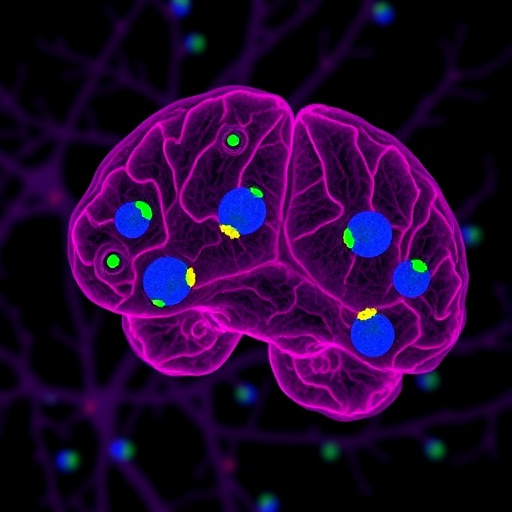In a groundbreaking study published in Nature Communications, a team of researchers has unveiled the complex interplay between steroid differentiation and the tumor microenvironment in adrenal tumors using an innovative single-nucleus atlas. This pioneering work sheds new light on the cellular heterogeneity and molecular mechanisms shaping tumor behavior, with significant implications for understanding tumor progression and developing precision therapies.
Adrenal tumors, notorious for their diverse clinical presentations and biological behaviors, have long puzzled oncologists and endocrinologists alike. These tumors arise from the adrenal cortex or medulla and can produce an array of steroids influencing systemic physiology. Despite advances in imaging and histopathological classification, the intricate cellular composition and microenvironmental factors guiding tumor evolution have remained elusive. The current research fills this critical knowledge gap by exploiting single-nucleus RNA sequencing technologies to dissect the tumor landscape at unparalleled resolution.
The study meticulously characterizes how steroidogenic differentiation programs within tumor cells directly correlate with distinct changes in the tumor microenvironment, including immune cell infiltration and stromal reorganization. By generating a single-nucleus atlas of adrenal tumors, the research delineates the molecular signatures that define various tumor subtypes and their microenvironmental niches. These findings reveal that steroid biosynthesis pathways are not mere bystanders; they actively sculpt the cellular ecosystem, modulating immune landscape and tissue architecture in a dynamic feedback loop.
This atlas is a culmination of cutting-edge high-throughput sequencing methods applied to hundreds of thousands of nuclei extracted from adrenal tumor specimens. The approach overcomes the limitations associated with traditional bulk or single-cell assays by preserving spatial information and overcoming cell dissociation biases. The integration of transcriptomic data with histological and clinical metadata allowed the researchers to link molecular phenotypes with functional consequences in tumor biology.
One of the most striking revelations of the study is the identification of distinct steroid-producing tumor cell populations that differentially influence the recruitment and activation status of immune cells. Tumor cells exhibiting intense steroidogenic activity were found to establish an immunosuppressive microenvironment characterized by regulatory T cells and myeloid-derived suppressor cells, thereby promoting immune evasion and tumor progression. Conversely, tumors with attenuated steroid differentiation showed enhanced cytotoxic immune cell presence, hinting at potential vulnerabilities amenable to immunotherapy.
Furthermore, the study uncovers the molecular crosstalk between steroidogenic tumor cells and cancer-associated fibroblasts (CAFs), which collectively orchestrate extracellular matrix remodeling and angiogenic processes. This stromal modulation fosters a tumor-permissive niche that supports malignancy and resistance to therapy. The orchestration of these microenvironmental components is tightly regulated at the transcriptional level, with key steroidogenic enzymes serving as nodal hubs.
Importantly, the single-nucleus atlas serves as a robust reference for unraveling heterogeneity across adrenocortical carcinoma and benign adenomas, enabling the stratification of tumors into clinically relevant categories based on their differentiation trajectories and microenvironmental configurations. This stratification has practical applications in prognostication and therapeutic targeting, potentially guiding the selection of patients for steroid-targeting interventions or immune checkpoint blockade.
From a methodological perspective, the employment of single-nucleus RNA sequencing allowed the researchers to circumvent challenges inherent to tumor dissociation, such as cellular stress and loss of fragile tumor populations. This technical advancement preserves the transcriptional integrity of various cell types, including rare and quiescent populations, thereby providing a comprehensive snapshot of the tumor ecosystem.
The atlas also highlights lineage plasticity within tumor cells, revealing transitional states between steroidogenic and non-steroidogenic phenotypes. Such plasticity may underlie therapy resistance and tumor recurrence, pointing toward the necessity of dynamic therapeutic strategies that account for tumor evolution over time. Understanding the regulators of these phenotypic shifts remains a priority for future research.
Moreover, by integrating spatial transcriptomics and in situ hybridization techniques, the study corroborates the spatial distribution patterns of different tumor and microenvironmental cell subsets. This spatial context is crucial for interpreting cell-cell interactions and niche-specific signaling pathways that undergird tumor biology. The spatial maps generated reinforce the notion of adrenal tumors as complex, ecosystem-level entities rather than mere collections of malignant cells.
The implications of these findings extend beyond adrenal tumors, offering conceptual frameworks for other steroidogenic malignancies such as prostate and ovarian cancers. The demonstration that steroid biosynthesis intricately modulates immune landscapes and stromal components may inspire cross-cancer comparative analyses and new therapeutic paradigms aimed at metabolic and microenvironmental vulnerabilities.
Furthermore, the study opens avenues for biomarker discovery to monitor tumor differentiation states and microenvironmental reprogramming in real-time. Such biomarkers could be instrumental in early detection, therapeutic monitoring, and guiding precision medicine initiatives. Pairing transcriptomic data with proteomic and metabolomic profiles will deepen the understanding of the functional impact of steroid differentiation.
In conclusion, the single-nucleus atlas of adrenal tumors stands as a monumental leap forward in tumor biology, elucidating how steroid differentiation actively shapes the microenvironment, influencing tumor growth, immune evasion, and therapeutic response. The integration of high-resolution transcriptomics with spatial and clinical data sets a new gold standard for tumor ecosystem analysis. Future research will undoubtedly build upon this atlas, unraveling additional layers of complexity and translating these insights into improved outcomes for patients afflicted by adrenal tumors and beyond.
As scientists continue to probe the molecular underpinnings of tumor heterogeneity, this study exemplifies the power of next-generation sequencing technologies to redefine our understanding of cancer. By bridging molecular biology, immunology, and endocrinology, the research heralds a new era where metabolic pathways and microenvironmental dynamics are harnessed for more effective, tailored cancer therapies. The impact of this work promises to resonate throughout oncology research and clinical practice for years to come.
Subject of Research: Adrenal Tumors, Steroid Differentiation, Tumor Microenvironment, Single-Nucleus RNA Sequencing
Article Title: Impact of steroid differentiation on tumor microenvironment revealed by single-nucleus atlas of adrenal tumors
Article References:
Jouinot, A., Martin, Y., Violon, F. et al. Impact of steroid differentiation on tumor microenvironment revealed by single-nucleus atlas of adrenal tumors. Nat Commun 16, 8860 (2025). https://doi.org/10.1038/s41467-025-63912-2
Image Credits: AI Generated




